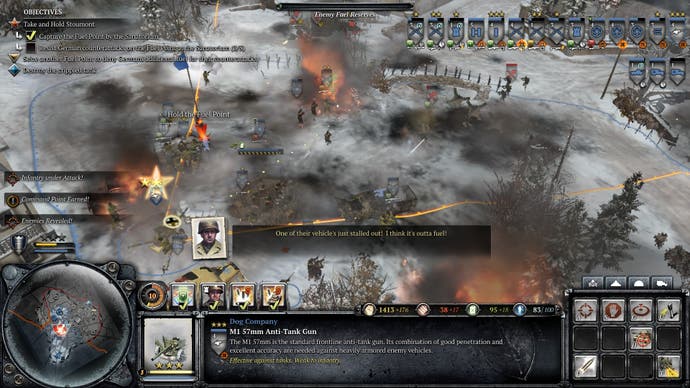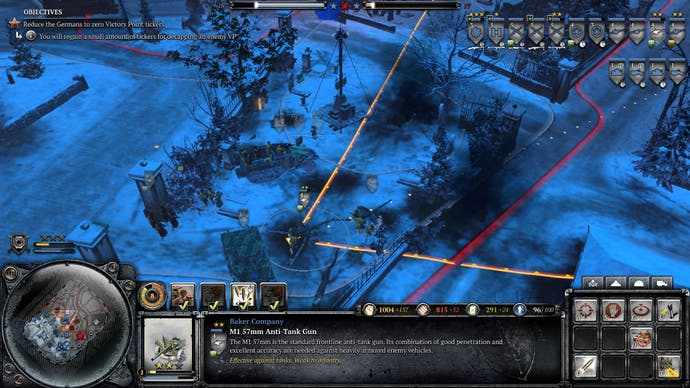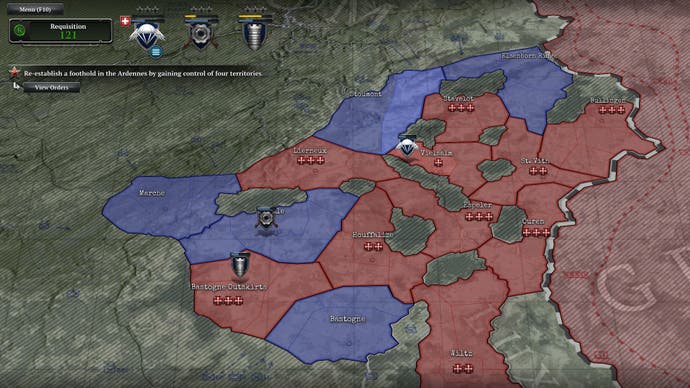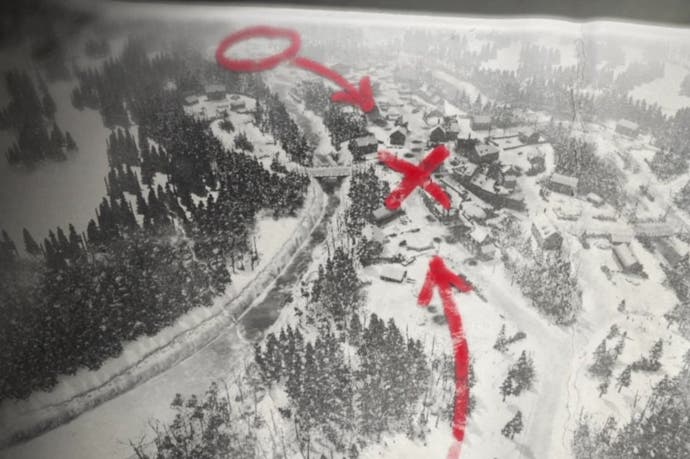Company of Heroes 2: Ardennes Assault review
FNG KIA.
Ardennes Assault, the single-player standalone expansion to Relic's Company of Heroes 2, is a game about stories. Not the affected and laboured stories that dragged down the narrative in the base game, but rather the unique incidental anecdotes that are shaped during play. With three varied companies to marshal (and a fourth via a premium add-on), some of these stories are rousing tales of valour and derring-do - like the time that paratroopers of the airborne company were dropped behind enemy lines with a .50 cal heavy machine gun and successfully took out a high-ranking German officer. Or when an entrenched squad of Dog Company's veteran assault engineers held out long enough against superior numbers to call in a support artillery barrage, but later perished as they covered their comrades' retreat.
These stories showcase Ardennes Assault at its dynamic best, but there are other stories that are far less noble. These are nightmarish tales of new recruits wading through menus looking for a way to reinforce decorated troops before they are wiped out, or not being able to find the keyboard command to group units together. There are horror stories of fresh-faced newbies growing frustrated at the lack of support or even a list of button-bindings, and subsequently losing several squads of soldiers to avoidable error before rage-quitting the mission and, soon after, the war.
This last is sadly indicative of a problem that plagues Ardennes Assault from start to finish and belies its status as a standalone expansion. You may not need the main game to play it, but the lack of guidance and support for new players suggests Relic assumes you have prior form. It's this oversight, by the the very people that should be on your side, that's going to dent the morale and the long-term buy-in prospects of newcomers to a far greater degree than any enemy offensive.

Those returning for another tour of duty will fare better, of course, but the introduction of three new commanders, specialised ability trees and a freedom of how and when you tackle missions means there's still much to learn and little meaningful assistance in doing so. Longer-term, these elements combine to create a rewarding campaign, but early on it introduces an unwelcome and pernicious learning curve. On the plus side, the problem is with how information is brought to the surface (or not), rather than with the elements themselves, so this could be easily fixed by a more comprehensive introduction to each company, alongside some basic post-launch tweaking of in-game menus.
Play long enough to overcome this dangerous lack of direction and Ardennes Assault becomes very compelling indeed. The introduction of three different commanders with three different companies at their disposal promotes a pleasingly freeform approach that's usually reserved for multiplayer battles. Grizzled veteran Derby, traditionalist Edwards and rakish reformed criminal Vastano offer a variety of stories and reflections in their pre-mission reports. Consequently, the human scale of their personal journeys is often more effective in conveying the trials of war than the wider narrative of the Battle of the Bulge as a whole.

You soon come to adopt favourites, just as you do with the varied troops that each has under their command. All three have infantry and vehicular options but the ability trees and specialisations that focus on the unique units of each company mean each plays sufficiently differently to one another to warrant multiple play-throughs. A level of persistence has been introduced to company veterancy and fatigue, bolstered by spending requisition points earned through victory to further enhance each company. This enhances the feeling of progress and consistency as you tackle increasingly difficult missions, and the nature of the strategic meta-map means that mission difficulty can change on each play-through depending on the choices that you make.
Mission goals range from defending heavily fortified points to securing safe passage for ambulances or reducing the enemy ticker to zero, while random optional objectives promote a risk/reward approach that tempts you to over-stretch yourself at key moments. Here, identifying what a handful of troops can achieve with some good cover and canny use of their abilities is key, as time or resource constraints often necessitate that a splinter group tackle these optional objectives. In its way, this promotes exploration of your troops' abilities far more effectively than the early missions designed to introduce each company.
Outside of missions, you move your companies around the strategic map that delineates allied and enemy territory. As you do so, random events occur that can help or hinder you or that offer a tantalising prize for tackling a particular mission within a certain timeframe. It's not the most exciting thing to look at, but the strategic meta-map promotes tactical positioning of your companies as you complete objectives that have a knock-on effect on your medium and long-term goals. Its open structure also offers a reason to revisit the campaign after you've bested its score of missions to try different approaches with different companies.

Ardennes Assault is very much geared toward maximising this potential for replay, and Relic is to be applauded for looking for new ways to add depth and value for those that thrive on single-player challenges over skirmishes in the multiplayer arena. From the freedom to tackle missions in any order to the knock-on effect that can have on the variable difficulty level of each mission, the campaign structure is set up to maximise the rewards of repeat play. Similarly, the persistent progress of the individual companies and the fact that the available requisition points won't allow you to fully explore every ability tree invite you to venture back - not to mention that the majority of the missions respond well to the different approaches that each company promotes.
There's no question that Ardennes Assault is a worthwhile addition to the Company of Heroes war chest and one that rewards investment and exploration with a tactically satisfying campaign. That said, such is the obtuse nature of its presentation of key concepts and even basic controls that new recruits should deduct a whole mark from that number below. Relic could and should look to ease the passage of those fresh-faced cadets. Help them avoid moments of unnecessary, crushing frustration and put them on the path to empowered victory, and they could nurture a new battalion of fans capable of deriving as much satisfaction from this experience as the seasoned vets.


